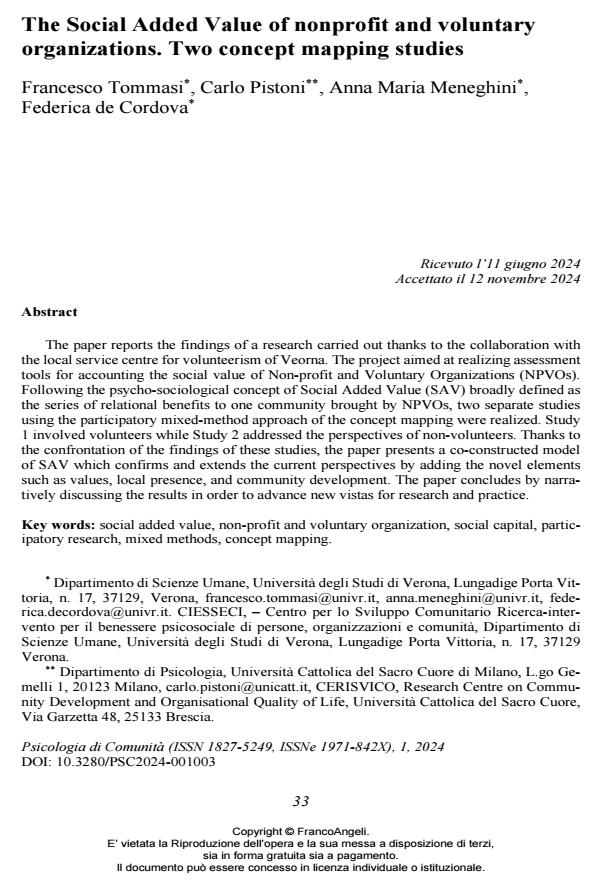The Social Added Value of nonprofit and voluntary organizations. Two concept mapping studies
Titolo Rivista PSICOLOGIA DI COMUNITA’
Autori/Curatori Francesco Tommasi, Carlo Pistoni, Anna Maria Meneghini, Federica de Cordova
Anno di pubblicazione 2025 Fascicolo 2024/1
Lingua Inglese Numero pagine 15 P. 33-47 Dimensione file 206 KB
DOI 10.3280/PSC2024-001003
Il DOI è il codice a barre della proprietà intellettuale: per saperne di più
clicca qui
Qui sotto puoi vedere in anteprima la prima pagina di questo articolo.
Se questo articolo ti interessa, lo puoi acquistare (e scaricare in formato pdf) seguendo le facili indicazioni per acquistare il download credit. Acquista Download Credits per scaricare questo Articolo in formato PDF

FrancoAngeli è membro della Publishers International Linking Association, Inc (PILA)associazione indipendente e non profit per facilitare (attraverso i servizi tecnologici implementati da CrossRef.org) l’accesso degli studiosi ai contenuti digitali nelle pubblicazioni professionali e scientifiche
The paper reports the findings of a research carried out thanks to the collaboration with the local service centre for volunteerism of Veorna. The project aimed at realizing assessment tools for accounting the social value of Non-profit and Voluntary Organizations (NPVOs). Following the psycho-sociological concept of Social Added Value (SAV) broadly defined as the series of relational benefits to one community brought by NPVOs, two separate studies using the participatory mixed-method approach of the concept mapping were realized. Study 1 involved volunteers while Study 2 addressed the perspectives of non-volunteers. Thanks to the confrontation of the findings of these studies, the paper presents a co-constructed model of SAV which confirms and extends the current perspectives by adding the novel elements such as values, local presence, and community development. The paper concludes by narratively discussing the results in order to advance new vistas for research and practice.
L’articolo riporta gli esiti di una ricerca svoltosi in collaborazione con il Centro di Servizio per il Volontariato di Verona in merito alla realizzazione di strumenti per la valutazione d’impatto degli Enti del Terzo Settore e delle Organizzazioni di Volontariato (ETS-OdV). Applicando il concetto psicosociologico di Valore Sociale Aggiunto (VSA) inteso come l’insieme di beni relazionali per la comunità di ETS-OdV, sono state realizzate due indagini basate sull’approccio partecipato-mixed method del concept mapping. Lo studio 1 ha coinvolto una popolazione di volontari mentre lo studio 2 di non-volontari del territorio. I risultati hanno confermato, attraverso un processo partecipato, la concettualizzazione fin qui sviluppata di VSA, estendendola anche a dimensioni non relazionali quali valori, presenza nel territorio, sviluppo di comunità. L’articolo conclude discutendo possibili linee di ricerca e intervento.
Parole chiave:valore sociale aggiunto, organizzazioni di volontariato, ricerca partecipata, concept mapping.
Francesco Tommasi, Carlo Pistoni, Anna Maria Meneghini, Federica de Cordova, The Social Added Value of nonprofit and voluntary organizations. Two concept mapping studies in "PSICOLOGIA DI COMUNITA’" 1/2024, pp 33-47, DOI: 10.3280/PSC2024-001003